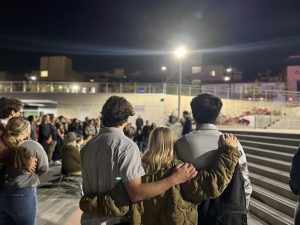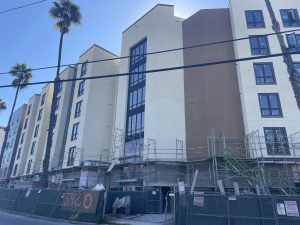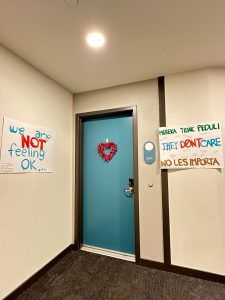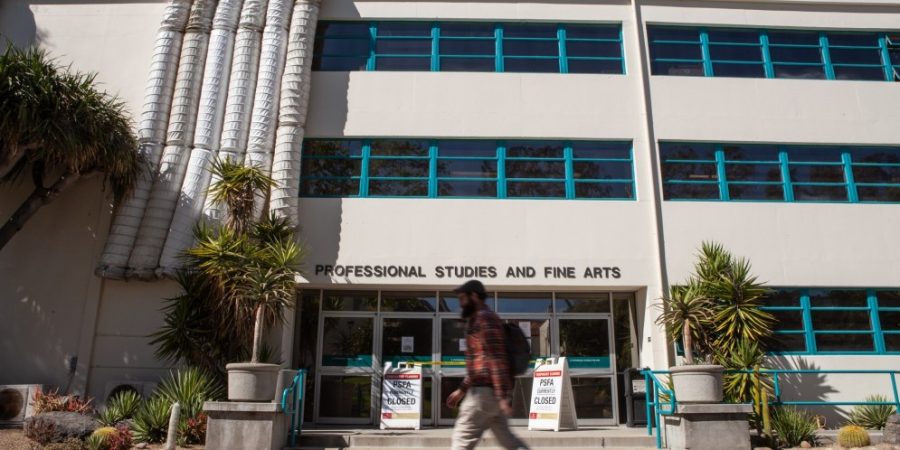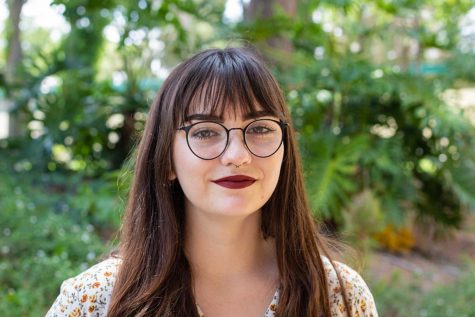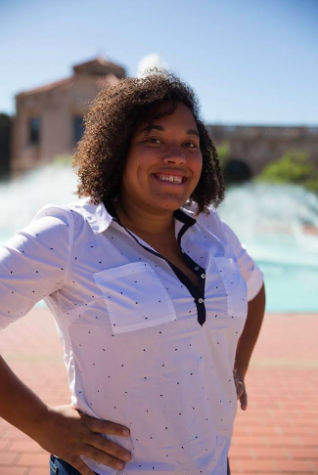This story is the product of a collaboration between The Daily Aztec and inewsource. Brad Racino is a senior investigative reporter for inewsource.
County officials are investigating odors that led San Diego State University to close a building on campus after faculty, students and others complained they were sick with sore throats, itchy eyes, nausea, headaches and nosebleeds.
The odors arose from a chemical used during roof repairs to the Professional Studies and Fine Arts building, which was closed on March 13 — six weeks after the university was told of the problem and began air monitoring tests. Students and professors who occupied the building despite the smells said the university did a poor job of notifying them or giving them options.
The building has four floors and houses the School of Journalism and Media Studies and the School of Public Affairs, as well as a small library, biology labs, and cultural and educational programs such as the Confucius Institute and Upward Bound.
inewsource asked the San Diego County Environmental Health Department on March 20 whether it had received any notice or complaints of the odors. A department spokeswoman said it hadn’t and that the agency primarily deals with chemical spills, illegal dumping and improper storage. She then referred the question to the county’s Air Pollution Control District.
The air district replied that it hadn’t received any complaints – and began an investigation the following day.
Investigators are talking with those affected, said Mahiany Luther, the district’s chief compliance officer. They’re also speaking with the contractor, SDSU’s environmental health department and an outside consultant the university hired to do air quality testing in March.
The district has a range of options if it finds violations occurred, including monetary penalties or a lawsuit. If serious enough violations occurred, it can refer the case for criminal prosecution. The district also could conclude the project was in compliance.
“This case is under investigation right now and at this point, we haven’t made a determination yet,” Luther told inewsource Wednesday.
She said she was surprised no one affected by the odors had reported it to the district, which enforces air pollution laws throughout the county.
“Anybody can submit a complaint to us” through an app, email or phone call, she said.
SDSU officials have repeatedly described the odors as non-toxic in campus emails and a website set up to answer questions, citing data from an air quality test performed by its Department of Environmental Health and Safety.
inewsource requested those test results by phone, email and an in-person visit, but the university has not yet provided them.
SDSU also hired Millennium Consulting to do additional tests in March and said its analysis showed non-toxic levels in the PSFA building. The university doesn’t expect Millennium’s costs to exceed $10,000.
The university also has not made those records public since “monitoring is ongoing” and “the report therefore remains in draft form.”
Nearly two dozen people have filed reports on campus about the odors. The university has scheduled two community forums on the topic. The first one is Wednesday, during the university’s spring break. The second one is April 8 — the day before the building is scheduled to reopen on April 9.
A slow response to odor problem
A resin was used to bind old roofing materials to new ones during repairs to the PSFA building. When students and faculty returned in late January, vapors from that resin quickly became a problem for the hundreds of people who use that building.
A school spokeswoman said the university received its first notice of the odors on Jan. 30, and SDSU’s Environmental Health and Safety team performed its first air monitoring tests that day.
Those test results “indicated within-range, low-level amounts of vapor levels, indicating that they were not toxic,” said La Monica Everett-Haynes, SDSU’s chief communications officer.
Yet students and faculty were largely kept in the dark. Some faculty learned from department officials about the air tests, and those professors alerted some students to the odor problems. But no campus-wide email alerted them to the air testing, no signs were posted in the building, and nothing was publicized on the school’s website about the hazard.
“When we started smelling the fumes and complaining, nothing was done about it,” said Kim Stull, coordinator for SDSU’s Hospitality and Tourism Management Master’s Program.
Stull was one of the people who suffered a sore throat, itchy eyes and headaches during the roof repair work. She said a co-worker also became nauseous and lightheaded.
“They put in some fans. It definitely didn’t feel like they were taking it seriously,” she said. “Before they did that work and opened that roof up, they should have removed us all from that building.”
Instead, hundreds of students and professors in more than 200 classes sat through biology, history, math, theater, Spanish and journalism lectures and labs until March 4, when campus officials offered the option for some departments and classes to relocate.
Mia Deptolla and Madeleine Leones, both students with classes in the building, told reporters on March 11 they hadn’t heard anything from the school about the odors.
“My class is right there,” Leones said, gesturing toward a fourth-floor classroom in the building, “and they haven’t told us anything.”
The university’s environmental contractor, Millennium, performed additional air testing on March 9 and again on March 11 – when the first email went out to the campus that the building would be closed.
“Dry and hot weather conditions tend to make the odors stronger and, while not known to be toxic, the odors are disruptive,” the email said. “With an abundance of caution for the health, wellness and safety of all occupants, we are preparing to move all students, faculty and staff before the higher temperatures projected for later this week.”
Some felt that notice was too little too late.
“There definitely needed to be more communication ahead of time, as opposed to trying to deal with it after the fact,” said Tomasa Mauricio, a program director for Upward Bound, a federally funded educational program for low-income and disadvantaged students housed in the PSFA building.
“I think they could have avoided a lot of frustration and a lot of fear,” Mauricio said.
In a statement to The Daily Aztec on March 12, the university said:
“While construction work is typically expected to produce strong odors that decrease over time, the situation at PSFA has been atypical. The project team has implemented numerous methods to prevent these odors from entering the building from outside air intake vents located on the roof. None of these mitigation efforts have been successful so far.”
On March 25, SDSU sent another campus email announcing the first of two open forums for the public to “learn more from experts about the construction project, the materials used in the roofing repairs, and any questions about risks to health and safety.”
“We welcome your participation, as we want to ensure that any outstanding questions you have are appropriately addressed before you return to the building,” the email read.
As of last week, the university said 22 people had filed “incident only” reports that they had experienced symptoms associated with the odors but had not sought medical treatment.



